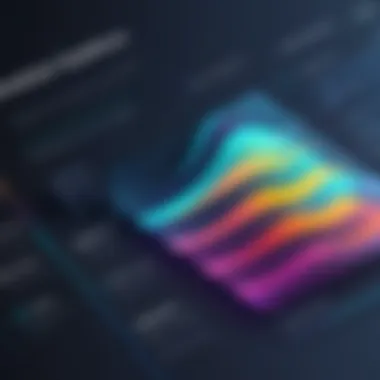Understanding Wave Apps Processing Fees: A Comprehensive Guide


Intro
This section begins by laying the foundation for understanding the complexities surrounding Wave Apps processing fees. As a prominent financial management tool, Wave Apps offers a suite of services including invoicing, accounting, and receipt scanning. However, the processing fees associated with these services can often lead to confusion among users.
Understanding how these fees are structured is essential for maximizing financial efficiency. The subsequent sections will delve deeply into the various aspects of Wave Apps’ fees, comparing them with industry standards, examining the factors that create variability, and discussing actionable strategies for minimizing overall costs associated with using this software toolkit.
Given the practicality of this information, both entrepreneurs and decision-makers can greatly benefit from a detailed comprehension of these fees, reinforcing the integrity of their financial resources.
Industry Overview
Current Trends in the Industry-specific Software Market
In recent years, the financial management software market has seen considerable growth. Small and medium-sized businesses are increasingly adopting cloud-based solutions for their transparency and affordability. The demand for automation tools that simplify invoicing, expense management, and bookkeeping is rising.
The emergence of integrations with popular payment systems, like PayPal and Stripe, further nourishes this trend. As businesses pivot towards online operations, understanding the associated fees becomes essential for sustaining profitability.
Key Challenges Faced by Buyers in the Industry
Buyers entering the market often face several challenges, notably:
- Complex Fee Structures: Many service providers present fees that vary based on numerous factors, making it hard for users to predict costs effectively.
- Lack of Clarity: During the initial stages of a relationship with service providers like Wave Apps, users often find the fee descriptions vague.
- Comparability Difficulties: A lack of standard metrics complicates comparisons between enterprises on bases like fee sustainability and overall value.
Emerging Technologies Impacting the Industry
New technologies, including artificial intelligence and machine learning, are reshaping the industry. These innovations enhance automation and predictive analytics, allowing tools to become more intuitive. For Wave Apps, as this tech continues to evolve, users might expect tailored solutions that improve financial forecasting, and in turn, affect the processing fees they incur.
Fee Structure of Wave Apps
Understanding the fee breakdown can clarify potential costs. Wave Apps primarily charges fees based on:
- Transaction fees for online payments
- Monthly subscription fees for premium features
- Additional costs for any integrations or add-ons chosen by the user
Aspects can vary widely, thus assessing personal or business financial needs is critical before adopting the platform.
Overview of Wave Apps
Wave Apps stands as a significant player in the financial management tools landscape. Its importance cannot be overstated, as it offers solutions tailored for small businesses and freelancers seeking effective ways to manage their finances.
Preface to Wave Apps
Wave Apps, launched in 2010, has become recognized for its user-friendly design. It is primarily cloud-based, meaning users can access their financial data from anywhere with an internet connection. This flexibility is invaluable for modern business environments, where mobility is crucial. Additionally, its core offerings are free to use, which serves as a unique selling point in a sea of paid financial software options. This accessibility enables a broad array of potential users who seek essential financial tools without burdensome upfront costs.
Core Features and Offerings
The primary features of Wave Apps include invoicing, expense tracking, accounting, and receipt scanning.
- Invoicing: Users can generate customized invoices quickly.
- Expense tracking: Allows for categorization and management of costs in real time.
- Accounting features: Automatic bookkeeping keeps records manageable.
- Receipt scanning: Users can upload pictures of receipts to categorize expenses the same day.
Each feature is designed to simplify financial management, equipping non-accountants with tools usually reserved for larger companies with extensive finance departments.
Target Users of Wave Apps
Wave Apps is aimed at small business owners, freelancers, and entrepreneurs. These users typically encounter challenges in managing invoicing, receipts, and accounting due to their limited resources. Wave addresses this intersection of need and resource. Moreover, many users appreciate the intuitive platform, which reduces the complexity often associated with financial management.


The focus on start-ups and freelancers helps ground Wave Apps within this specific market segment, fostering strong community support and resources. Ultimately, Wave Apps serves as an essential resource for anyone looking for a low-cost, high-value solution in financial management.
Thus, understanding Wave Apps’ core offerings aligns perfectly with a deeper analysis of the processing fees it incurs and the impact these fees have on the user experience.
Understanding Processing Fees
Processing fees are a critical aspect of managing online transactions, particularly relevant when utilizing Wave Apps. Hidden in the background of financial operations, they directly impact both the transparency and the overall cost-effectiveness of digital transactions. Understanding these fees not only assists users in making well-informed choices but also helps predict draining costs on business margins.
Processing fees depend on various elements, including transaction volume, geographical location, and chosen payment methods. Grasping these nuances empowers businesses and individuals to strategize how to manage their expansion while minimizing operational expenses.
What Are Processing Fees?
Processing fees are the costs associated with the handling of transactions between businesses and financial institutions. These charges may apply anytime there is a transfer of funds, whether the transactions are credit card payments, bank transfers, or digital payment channels. In aircondition, these usually constitute a percentage of the overall transaction value or a fixed charge per transaction.
For instance, a credit card payment may incur a 2.9% fee along with a fixed sum (for example, $0.30) per transaction. Here’s a summary of potential processing fees:
- Transaction-based Fees: Charged based on the total transactional amount.
- Account or Monthly Fees: Regular charges incurred just for having an account, irrespective of transactions.
- Service Charges: Additional fees that may apply for special services like integrating software.
"Understanding processing fees is a vital skill in maintaining a sustainable financial operation. It allows for optimal donation on investments and expenditures to harm control financial flows."
Importance of Processing Fees in Financial Software
Processing fees occupy a crucial role in financial software, largely affecting profitability and operational efficiency. First, they can significantly impact cash flow and pricing strategies. These fees often creep up on users, leading to skewed perceptions of net earnings. Thus, accounting for processing fees meticulously is essential while forecasting and reporting financial outcomes.
Processing fees also demand clarity in business plans and strategies. Commits aware of associated costs tend to negotiate better terms with payment processors, perhaps securing lower rates after establishing significant transaction histories. Additionally, examining an entire portfolio of expenses could emphasize the fluctuations in fees, aiding firms in maximizing their resource allocation. Overall, here are key reasons why understanding processing fees is essential:
- Improved Financial Management: Exact comprehension of these fees fosters trust in rolled out budgets.
- Informed Decision Making: Accurate knowledge arms entrepreneurs with insights on their operational capacity.
- Cost Reduction Opportunities: Reveals pathways cut costs that result in savings.
By evaluating processing fees, users can take proactive steps to optimize their transactions while navigating the digital financial landscape. It provides significant insight into expenditure patterns, enabling businesses to embed cost considerations in their decision-making processes.
Wave Apps Processing Fees Breakdown
Understanding the processing fees associated with Wave Apps is crucial for businesses and individual users aiming to effectively manage their finances. The structure and types of fees incurred can significantly impact overall costs. By dissecting this area, users can make informed decisions that align with their financial strategies and operational budgets.
Types of Fees Incurred
Wave Apps implements a variety of fees that users should be aware of to anticipate their financial obligations accurately. Some of the main type of fees incuded include:
- Transaction Fees: These are often charged every time a money movement occurs, whether through invoicing, payments received, or money sent out.
- Subscription Fees: For users opting for premium features within Wave Apps, a standard monthly fee may apply. These costs can vary based on the specific features selected.
- Chargeback Fees: If a customer disputes a transaction, it may lead to a chargeback fee, adding unexpected expenses to a business’s operating budget.
- Currency Conversion Fees: Clients making international transactions might face additional charges related to currency exchange rates.
It is best to stay above trends and regularly visit Wave Apps’ pricing page for updated fee structures, as they can change.
Fee Structure Explained
The fee structure in Wave Apps can seem complicated, yet breaking it down makes it understandable. First, it is important to note that Wave Apps uses a percentage-based fee model. The exact percentage depends on various factors such as the type of transaction being processed. Additionally, there is a fixed fee involved for each transaction, which is generally predictable and allows for better budgeting by users.
For example, if a user bills a client for a service via purchase, one can expect to incur both a percentage fee based on the total amount of the invoice and a fixed rate charge. This dual structure ensures Wave can maintain service quality while providing features that users require.
Understanding how these fees operate not only informs users but can lead to better financial management and business decisions.
Typical Costs Associated with Transactions


Costs incurred while utilizing Wave Apps can vary widely based on usage patterns and the services leveraged. Below is an overview of typical costs that users might encounter:
- Invoice Processing: Typically around 2.9% plus $0.30 for each successful transaction.
- Recurring Payments: Costs can remain consistent similar to invoice processing, applying the same percentages as above.
- Payroll Services: For users opting for payroll, additional fees usually apply based on the number of employees registered. The costs stay flexible, dependent on personal business structure.
Estimating total costs beforehand will help in forming a strong financial plan and budget strategically. The effort allows users to identify potential areas for reducing overhead fees while managing their finances better.
Factors Influencing Processing Fees
Understanding the factors that can influence processing fees for transactions in Wave Apps is essential for businesses and individual users. These factors are not always immediately apparent, yet they significantly impact cost dynamics, which ultimately influence budgeting decisions. By analyzing each element, users can better understand how to manage these expenses effectively. Here we delve into three primary areas that affect the fees users encounter during payment processing: transaction volume and size, geographical considerations, and payment method selection.
Transaction Volume and Size
Transaction volume and size are two determining elements when it comes to processing fees. In general, larger transactions tend to attract higher fees due to increased risk and resource allocation from the payment processors. High transaction volume can also influence fees. Many services, including Wave Apps, offer tiered pricing structures. This means that as a business processes a greater number of transactions, they could unlock reduced rates per transaction.
Businesses should consider not just the size of single transactions but also the collective impact of multiple small transactions. For instance, frequent low-value sales can accumulate fees that, while individually minor, may collectively amount to significant costs.
Geographical Considerations
Geography plays a critical role in determining processing fees. Specific countries or regions have different regulations on payment processing, which can affect the charges incurred. International transactions might attract higher fees due to currency conversion and cross-border processing costs. It is important for users to assess their customer base geography when estimating transaction fees.
Different markets may also have unique factors affecting the fees tied to their financial infrastructure, like security preparations and fraud protection measures. Understanding these geographical implications can help organizations strategize what markets are feasible for expansion while keeping an eye on transactional efficiencies.
Payment Method Selection
The choice of payment method presented to customers significantly influences processing fees as well. Credit card payments often incur higher fees compared to other methods, such as debit cards or bank transfers. Each payment provider has varying agreements in place with these methods which results in different costs to businesses.
By analyzing which payment options present the best balance of accessibility to users and cost control for the business, decision-makers can create smarter payment strategies. It may be beneficial to provide users with a selection of payment methods while also keeping margins in consideration.
By taking a proactive approach, users of Wave Apps can adapt their payment processing strategies to potentially lower processing fees by balancing volume, method, and geography in an informed way.
Understanding these factors offers a roadmap for action. Rather than viewing processing fees as an unchangeable burden, they can be strategically managed through careful selections and appreciations of workload style on overall fees.
Comparison with Industry Standards
Understanding the comparison of Wave Apps processing fees with industry standards is crucial for informed decision-making. Businesses need to comprehend how these fees line up against counterparts in financial software. This can influence which platform they choose based solely on expense management.
When evaluating different financial software, business owners should consider several elements:
- Fee Transparency: Clear communication about fees helps build trust. This is significant for decision-makers who need assurance that there are no hidden costs in their chosen software.
- Market Prudence: The typical processing fees set by competitors inform businesses about what they can expect to pay. This sets boundaries on budget and expectations for many enterprises.
- Value for Money: A lower fee may seem favorable initially; however, this must be balanced with the features and benefits provided.
A wise approach is to track any charges undertaken by competitors. This practice fosters a more grounded understanding of realistic expectations and increases negotiation strength with providers.
Wave Apps vs.
Competitors
Wave Apps holds a competitive position when analyzed against alternatives. Larger competitors like QuickBooks or FreshBooks display differing fee structures, often posing challenges for affordability.
Wave Apps typically sets a standard structure, meaning most users know what to expect. The processing fee can also be noticed by type of transaction—credit card payments often have different conditions versus direct bank transfers.
Additionally, while comparing loyalty programs and additional fees, key players usually try to legitimate their charges through additional features.
Key attributes distinguishing Wave might include:


- No Monthly Fees: Unlike many competitors, Wave Apps offers essential services at no monthly fee.
- Card Processing Fee: This may vary between Wave Apps, typically around 2.9%, aligning well with other market giants.
- Accessibility: User experience can sway opinions and choices in payable software. User reviews lend perspective no less than competitors' features.
Fee Variability in Different Financial Software
The financial software market entails distinct fee structures contributing to variability. Processing fees fluctuate due to several core factors. These include but are not limited to:
- Transactions Methods: Credit card, debit card, and bank transfer fees can show significant difference.
- Volume of Transactions: As a rule, more considerable transaction volumes may lead to advantageous pricing from different vendors, very crucial for high-traffic businesses.
- Promotional Tax Innovations: Startups may offer reduced fees for early-stage businesses to tempt them onto their platforms.
Consistently regarding fee variability in the context of Industry can allow managers to assess their investments clearly. Evaluating potential fees at straightforward checkpoints can ensure better comprehension of financial implications in operations. Factors combined lead to an informed selection aligning with business performance expectations.
Understanding the complete picture of processing fees helps businesses avoid overspending and enhances strategic decision-making for future finances.
Strategies for Minimizing Processing Fees
Minimizing processing fees is crucial for businesses using Wave Apps. Awareness of these fees not only saves money but also influences overall financial health. As organizations utilize Wave Apps for transactions, developing strategies to manage costs effectively becomes paramount.
Selecting the Right Payment Methods
Choosing the appropriate payment methods can significantly affect processing fees. Wave Apps allows for various options including credit cards, debit cards, and bank transfers. Each method has distinct fee structures:
- Credit Cards: Generally, they incur higher transaction fees. Users should consider their average transaction sizes to evaluate cost-effectiveness.
- Debit Cards: These usually carry lower fees than credit cards. Businesses processing smaller amounts might benefit more from accepting debit card payments.
- Bank Transfers: While often having low fees, if minimally charged at all, it is important to ensure the speed of transactions remains acceptable to clients.
Understanding customer preferences play an imperative role to succeed in selecting the right method. Offering multiple options can enhance customer experience, which could indirectly lower operational costs by increasing payment success rates.
Understanding Fee Structures for Better Decisions
Having a firm grasp of the fee structures will lead to smarter decision-making. The fees associated with Wave Apps are not just passive charges, they are factors that impact profitability:
- Fixed Fees vs. Variable Fees: Knowing if the fees are tiered based on different volume brackets enables businesses to strategize towards higher volumes instead of paying percentage-based fees that escalate with each transaction.
- Monthly vs. Per-Transaction Fees: Some businesses calculate costs to find out if a flat monthly fee could potentially offer savings for their month-to-month transaction volumes.
- Hidden Fees: Awareness of potential extra charges related to returns and chargebacks will protect against unexpected expenses.
By analyzing these elements diligently, users can optimize their payment processor usage, ensuring they pay only what is necessary while maximizing gains.
Leveraging Wave Apps Features to Reduce Costs
Wave Apps comes equipped with various features designed to assist users in minimizing costs related to processing fees. Utilizing these tools effectively can amplify financial benefits:
- Payment Reminders: Leveraging automated reminders can expedite timely payments. Faster payments reduce administrative costs and payment anomalies that can lead to extra charges.
- Invoice Customization: Tailored invoices with explicit payment terms can facilitate customer adherence, thus lowering late payments that often accrue additional fees.
- Batch Processing: Combining multiple transactions into a single processing batch minimizes costs compared to handling each one individually.
Using these features strategically can yield tangible savings in the long run. This promotes savvy financial management while reinforcing a robust bottom line.
Understanding and actively managing processing fees could be the difference between profitability and loss for many businesses using Wave Apps.
Closure
Understanding Wave Apps' processing fees is crucial for businesses and individuals relying on this financial tool. Fees can significantly impact overall costs. Carefully evaluating these expenses ensures that users allocate their financial resources effectively.
Final Thoughts on Wave Apps Processing Fees
As outlined throughout the article, Wave Apps offers a streamlined solution for managing finances. Nonetheless, the processing fees associated with their services require attention. Small businesses and freelancers must grasp both the fee structure and factors affecting these charges.
Users should maintain awareness of the potential fees attached to various transaction types. For example, credit card payments often entail higher processing costs than ACH transfers. Understanding these dynamics enables users to avoid unexpected charges that can erode margins.
“An accountant’s key is not just managing finances but optimizing every cost aspect.” Consider switching payment methods or renegotiating contracts if utilization patterns show that fees may be higher than expected.
The Future of Processing Fees in Financial Software
The landscape of processing fees is evolving. As more businesses transition to digital platforms and non-traditional payment methods, competition may drive down processing fees. Additionally, businesses are becoming increasingly capable of negotiating better fee structures.
More advanced technologies, such as machine learning and AI, will likely predict fees based on spending behaviors. Ultimately, understanding the future shifts in processing fees will empower users to navigate financial decisions with greater control. To remain competitive, Wave Apps should expedite changes to reduce processing costs, keeping user needs at the forefront.
The proactive management of these fees not only supports financial health but also enhances operational efficiency. By fostering an understanding of migrating costs, stakeholders in financial software can remain prepared for future adjustments.



